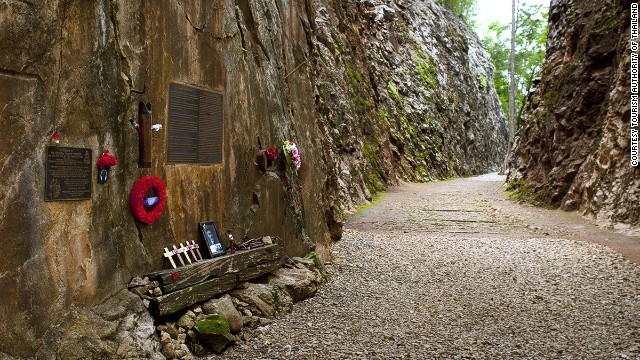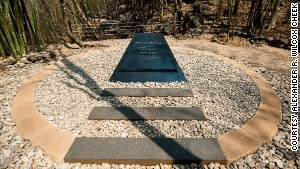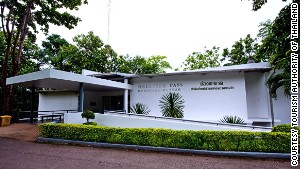Hellfire Pass: TripAdvisor's top museum in Thailand recounts gruesome history
November 6, 2014 -- Updated 1142 GMT (1942 HKT)

In
Thailand, World War II POWs cut through this rock by hand. It's one of
the most evocative places on the planet for travelers with an interest
in the war.
STORY HIGHLIGHTS
- Named the best museum in Thailand, Hellfire Pass Memorial Museum commemorates the notorious Death Railway
- During World War II, thousands of POWs and workers died building a railway for Japanese military
- Visitors can walk along the narrow trench of Hellfire Pass and other WWII monuments nearby
- Audio headset includes voices of survivors who describe atrocities they endured
Editor's note: CNN's On the Road series brings
you a greater insight into the customs and culture of countries across
the world. During November, CNN International explores the places,
people and passions unique to Thailand. Read CNN's special reports policy.
(CNN) -- The steep rock walls of Thailand's
Hellfire Pass symbolize the slavery, starvation, torture and lost lives
of thousands of POWs and Asian civilians during World War II, when
Japan forced them to build the infamous Death Railway to boost its
invasion of Burma.
At today's Hellfire Pass
Memorial Museum, visitors can share the misery and memories of those
years, and learn from survivors who tell what happened and why.
Recently named the best museum in Thailand and ranked among the top five in Asia by TripAdvisor, the haunting site and museum are called a "must" by the travel website.
Fifty miles away, in the
town of Kanchanaburi (about 75 miles west of Bangkok, near Thailand's
border with Myanmar), evocative ceremonies take place annually from
November 28 to December 7 during River Kwai Bridge Week, commemorating
the Allied bombing of the area, which began on November 28, 1944.
Events include cultural
performances, plus a sound and light show portraying the history of the
Death Railway, which crossed the so-called Bridge on the River Kwai on
its route through Hellfire Pass.
More than 16,000 enslaved British, Dutch, Australian and American POWs perished at these sites.
More than 90,000 Asians also died from starvation and disease during their forced labor, according to the United Kingdom's Forces War Records.
Together, the sites make
this corner of jungle in Thailand one of the most sobering and evocative
places on the planet for travelers with an interest in the horrifying
events of World War II.
Fatal railway
"Hellfire Pass" and "Death Railway" are terms coined by POWs whose fate was sealed in a sinister, deadly agreement.
In August 1942,
Thailand's prime minister Field Marshal Phibun Songkhram signed an
agreement with Japan to allow the laying of a single-meter-gauge railway
track toward British colonial Burma (now Myanmar).
In October 1943, Japan
began transporting troops and supplies on that finished railway through
newly carved Hellfire Pass, to support its 1942 Burma invasion.
For slave labor, Tokyo used more than 60,000 POWs -- 30,000 British, 18,000 Dutch, 13,000 Australians and 700 Americans.
Most were captured when
Britain surrendered its colonial hold on Singapore in February 1942,
while other POWs were seized in Britain's Malaysia and Dutch-held
Indonesia.

Heat, humidity and mosquitoes are part of the experience.
About one-fifth of the
POWs died from untreated diseases and starvation -- they were given
watery gruel rations and sadistic punishments while building Hellfire
Pass and the Death Railway. Executions of prisoners and laborers were
common.
Tokyo was in a brutal
rush, so its commanders in Thailand forced up to 180,000 Indians,
Malayans, Singaporean Chinese, Tamils and other Asians to labor at the
sites under similar conditions, according to the Forces War Records.
The railway totaled 260
miles (415 kilometers), including 190 miles (304 kilometers) in Thailand
from Nong Pladuk to Hellfire Pass on the Thai-Burma border, plus 70
miles (111 kilometers) to reach Thanbyuzayat inside Burma, where it
linked trains to Rangoon.
When the Allies began bombing the railway in November 1944 and 1945, they killed some POWs laboring there.
Allied aerial bombing during 1945 also destroyed almost every railway bridge throughout Thailand.
Some railroad tracks near Kanchanaburi survived the war, but Hellfire Pass disappeared amid jungle growth.
Visiting Hellfire Pass
In the 1980s, a handful
of Australian survivors rediscovered the overgrown Hellfire Pass section
of the route and campaigned to turn it into a memorial.
Guided tours are now available, but many people prefer to linger on their own.
While most tourists
visit the River Kwai bridge and main POW cemetery at Kanchanaburi,
others say they experience stronger and more profound feelings at
Hellfire Pass.
Taxis and local buses are available between the sites.
You can walk through
Hellfire Pass's narrow 85-foot-deep (26 meter) trench in the Tenasserim
Hills along its 1,640-foot-long (500 meter) track.
POWs and forced laborers
painstakingly hacked open the mass of solid rock using hand tools,
making it wide enough for the train to slide through.

Hellfire Pass Memorial Museum offers videos, photographs, drawings, tools and testimony.
Nearby, the TripAdvisor top-rated and air-conditioned Hellfire Pass Memorial Museum is run by the Office of Australian War Graves. It offers videos, photographs, drawings, tools and testimony.
The highly recommended
portable audio headset includes the voices of survivors who describe
atrocities they endured, which you can listen to while wandering between
Hellfire Pass's stone walls.
From the museum, a
walking trail of a few hundred yards leads to Hellfire Pass, also called
the Konyu Cutting, and you can continue walking down the abandoned
railway line for a couple of miles.
That route reveals a gorgeous valley, other rock "cutting" railway passes and a couple of trestle bridges.
The jungle is often hot
and humid, with voracious mosquitoes. Visitors unprepared to deal with
either usually find the going uncomfortable.
Nearby WWII attractions
Back in town, the
manicured Kanchanaburi "Don Rak" War Cemetery includes most of the POWs'
remains recovered from nearby mass graves.
POWs are also interred at nearby Chungkai, and in Myanmar at Thanbyuzayat.
The excellent
Thailand-Burma Railway Center, next to the cemetery, displays research
by an Australian who was a Commonwealth War Graves Commission manager of
the Kanchanaburi and Chungkai war cemeteries.
The center includes
extensive details about the railway, Hellfire Pass, POW camps and
cemetery sites in Thailand, plus biographies and artifacts.
Visitors can also tour Kanchanaburi's Thai-owned JEATH Museum and World War II Museum.
Managed by a Thai
Buddhist temple, the JEATH "Wat Tai" Museum's design is similar to the
bamboo-and-thatch shacks where POWs were housed, and displays POW
testimonies and paintings, plus news reports and other objects.
Scary, painted wooden
effigies show life-sized prisoners being tortured, dying and laboring on
the railway, alongside statues of Hitler, Tojo, Stalin and other
wartime leaders.
The acronym JEATH
indicates the countries of Japan, England, Australia, Thailand and
Holland, which were intertwined in the Death Railway's creation.
Nearby was the so-called "Bridge on the River Kwai," a POW-built steel and concrete structure with 11 curved spans.
Next to that was a wooden trestle railway bridge, still partially preserved.
Both bridges were completed in 1943, and repeatedly bombed by British and U.S. warplanes.
Today, tourists can take
a short train ride across a fully functional, duplicate "Bridge on the
River Kwai" closer to Kanchanaburi -- built to resemble the obliterated
original.
You can also walk across the bridge and take boats on the river below.
Hellfire Pass in popular culture
The Death Railway's main
structure was immortalized in the partially fictional 1957 movie
classic, "The Bridge on the River Kwai."
In 2013, Colin Firth and Nicole Kidman starred in "The Railway Man," portraying Death Railway survivor and former POW Eric Lomax.
On October 14,
Australian author Richard Flanagan, 53, won Britain's Booker Prize for
his novel titled, "The Narrow Road to the Deep North," describing his
father's experience as a POW who survived after laboring on the Death
Railway.
Hellfire Pass Memorial Museum and walking trail, Kanchanaburi, Thailand; open daily 9 a.m.-4 p.m.
Thailand-Burma Railway Center and
Kanchanaburi "Don Rak" War Cemetery, Sangchuto Road, Kanchanaburi,
Thailand; +66 3451 2721; open daily 9 a.m.-5 p.m.; entry fee THB120 ($4)
JEATH War Museum,
inside Wat Chai Chumphon Temple, near the bridge in Kanchanaburi,
Thailand; open daily from 8:30 a.m.-4:30 p.m.; entry fee THB30 ($1)
Richard S.
Ehrlich has reported news for international media from Asia since 1978,
based in Hong Kong, New Delhi and now Bangkok.
CNN's On the Road series often
carries sponsorship originating from the countries we profile. However
CNN retains full editorial control over all of its reports. Read the policy.

ไม่มีความคิดเห็น:
แสดงความคิดเห็น